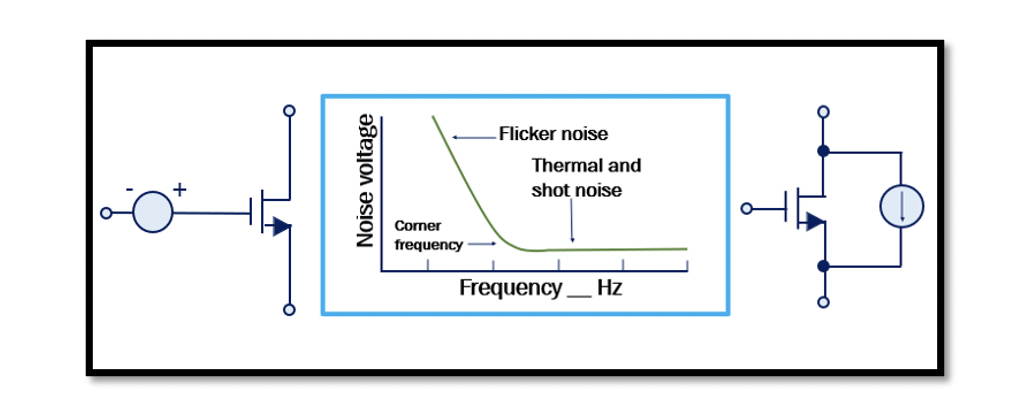
Different Types of Noise in RF Devices
In the previous section, Noise in Radio Frequency Systems, we discussed that noise in the frequency domain gives more useful information than that delivered in the time domain. Therefore, we go through the power spectral density (PSD). The below two diagrams shows noise in the time and frequency domain. In the frequency domain, we can observe different power at different frequencies. The frequency-domain can provide insights that can be useful in RF design.
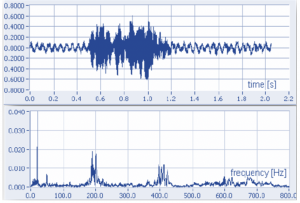
Previously we discussed different categories of noise (pink, white, and band-limited noise). Different types of noise can be specific to devices.
Thermal Noise: It occurs due to temperature, which leads to the random movement of charges- typically electrons in a conductor.
Shot Noise: This noise arises from the time-dependent fluctuations in electric current.
Phase Noise: This form of noise is visible on radio frequency and other signals. It appears in the form of perturbations on the signal or phase jitter.
Flicker Noise: It occurs in almost all the electronic components and is inversely proportional to frequency. If the frequency increases, the flicker noise decreases. It often occurs as resistance fluctuation.
Avalanch Noise: It occurs in the PN junction of transistors that are operated in a region at or close to the avalanche breakdown point.
All the active and passive devices have their own noise. The device noise added to the external noise degrades the SNR at the output. This noise is generated by the components used to design the blocks, like resistor, transistor & non-ideal inductor. These components contribute to the total noise; hence SNR input is not equal to SNR output. Therefore, we can also say that MOSFET and BJT generate noise. An ideal inductor is noise-less as it doesn’t have any parasitic capacitance associated with it. However, in the real world, we will always have a non-ideal inductor with small resistance and parasitic capacitance that generates noise but not as much as resistors and transistors.
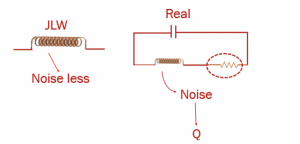
Noise in Resistor: The kind of noise produced by the resistor is Thermal Noise. Thermal energy leads to random agitation of charge carriers in resistors, and therefore it generates noise. Due to the heat, the charge starts moving randomly and produces noise. This noise is shown with PSD in two ways, either with voltage or parallel current source. The thermal noise depends on the value of the resistor and temperature. Increasing the temperature will increase the thermal agitation, therefore, increasing the noise level. In current, it is inversely proportional to the value of R as shown in the equations:

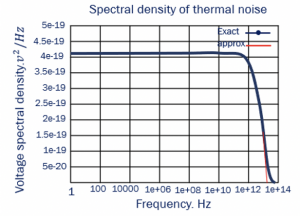
The diagram shows the voltage spectral density for thermal noise. It can be observed that spectral density is constant with frequency as there is no frequency component in the equation. There is a point shown in the diagram when the frequency reaches a very high value, and the noise starts to decrease. However, many applications work in constant spectral density.
Noise in Transistor: There are two types of noise associated with MOS: Thermal Noise and Flicker Noise. The transistor has charge carriers within the channel, and these charges move randomly due to temperature. Therefore having thermal noise. It can be modeled with a parallel current source or voltage source at the gate of the transistor.

In the equation, ‘γ’ is the excess noise coefficient, and it is constant. The γ is 2/3 for long channel transistor and 2 for short channel transistor. Therefore we can say that γ for short-channel transistors are higher than γ for long channel transistors. As the size of devices is getting smaller, it generates more noise, which is one of the major drawbacks.

There are two other noise sources in the MOS transistor: Thermal Channel noise at gate resistance and gate-induced noise current. For a long transistor, the W is high, and there are resistors in the polysilicon producing thermal noise. So it acts like the thermal noise associated with the resistor, as discussed before. Similarly, there is a gate-induced noise current. These two noises can be ignored as they have a really small value compare to thermal noise.
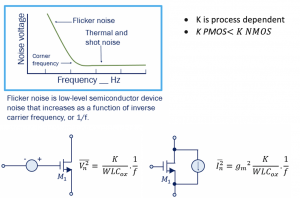
Flicker noise always appears in the low frequencies, it is inversely proportional to frequency, and if we decrease the frequency, the flicker noise will increase, as shown in the diagram. The flicker noise can only be reduced by increasing transistor size, but it can cause other issues like size constraints and higher parasitic. It is a kind of trade-off between the size parasitic and noise. The PSD of thermal noise is the constant bit the flicker noise is changing with frequency. So we can say that flicker noise is dominant compared to thermal noise. K (Boltzman constant) for PMOS transistor is lower than NMOS, which means PMOS will have lower flicker noise comparatively. Hence it is sometimes used as input to decrease the flicker noise. Similar to thermal noise, the circuit can be model with voltage and current source.




